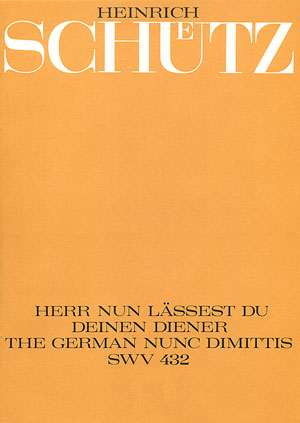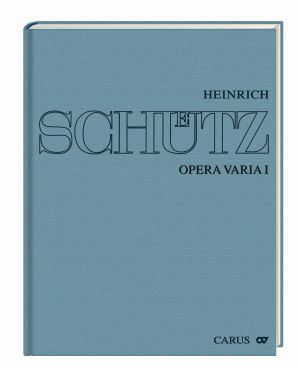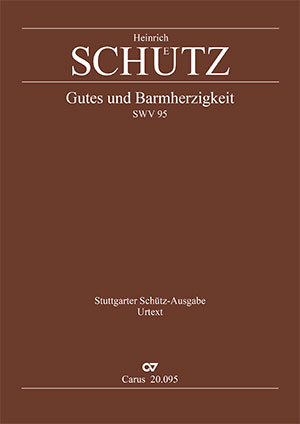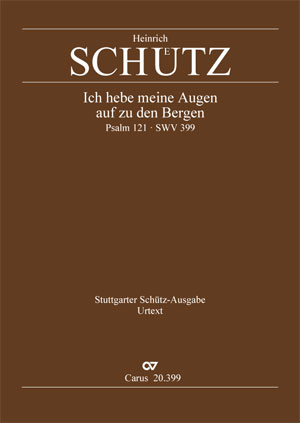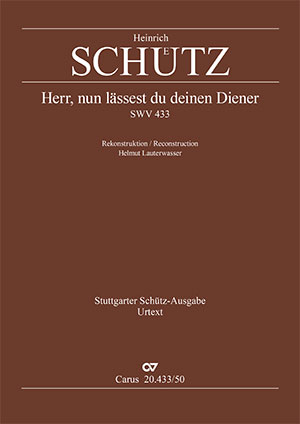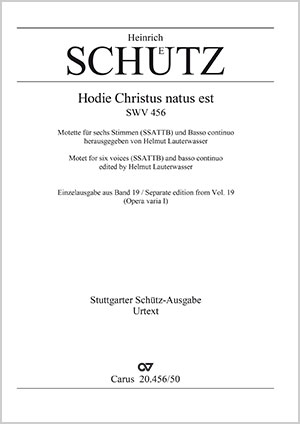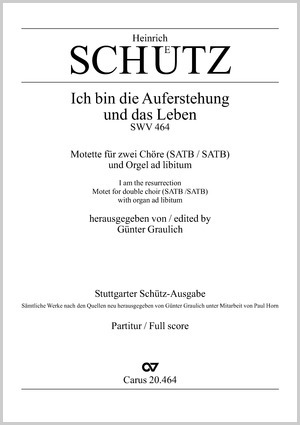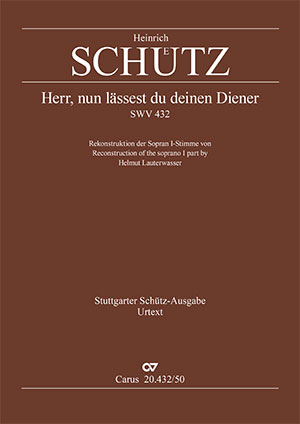
Schütz set the German Nunc dimittis “Herr, nun lässest du deinen Diener” on the death of the Saxon Elector Johann Georg I in 1656 “in two different ways” and had these printed. But unfortunately the 1st soprano part is lost. In this edition it has been reconstructed by Helmut Lauterwasser for the Stuttgart Schütz Edition. In another edition, Carus also offers the historic reconstruction of the part made by Heinrich von Herzogenberg in 1892 (available as Carus 20.432).
Separate edition taken from Vol. 19 of the Stuttgart Schütz Edition (Complete Edition Carus 20.919).
Purchase
Additional product information
-
Composer
Heinrich Schütz
| 1585-1672Heinrich Schütz is regarded as the first German musician of European stature. As a choirboy from 1599 at the court of Landgrave Moritz of Hessen-Kassel, he received a thorough education. In 1608 he began a law degree in Marburg, but broke this off in 1609 in order, with the support of the Landgrave, to study composition with Giovanni Gabrieli, organist at St Mark’s in Venice. In 1613 Schütz returned to Kassel, but two years later was enticed away by Elector Johann Georg I of Saxony to the Dresden court as “Organist und Director der Musica”, where he held the position of Hofkapellmeister (court Kapellmeister) from 1617 until his death. Schütz’s great cycles of vocal works marked the high point of his reputation in Germany and northern Europe. But these represent only part of Schütz’s output; individual works are represented in printed collections with works by other composers, others only survive in manuscript, and much has been lost. The Stuttgart Schütz Edition makes available Schütz’s complete oeuvre, and all works are also published in practical Urtext editions. Personal details
-
Editor
Helmut Lauterwasser
-
Continuo realization
Paul Horn
| 1922-2016Paul Horn war ein deutscher Kirchenmusiker, Organist, Komponist und Musikwissenschaftler. Er studierte Kirchenmusik und Orgel an der Evangelischen Kirchenmusikschule Esslingen am Neckar bei Hans-Arnold Metzger und Musikwissenschaft, Theologie und Geschichte an der Universität Tübingen. Seine berufliche Laufbahn begann als Kantor an der Evangelischen Michaelskirche in Stuttgart-Degerloch. 1954 wurde er Kantor an der Evangelischen Stadtkirche Ravensburg, eine Position, die er bis zu seiner Pensionierung innehatte. Als Musikwissenschaftler arbeitete Horn bis ins hohe Alter eng mit Carus zusammen. So stammen zahlreiche Carus-Klavierauszüge aus seiner Feder. Personal details
-
Continuo realization
Paul Horn
| 1922-2016Paul Horn war ein deutscher Kirchenmusiker, Organist, Komponist und Musikwissenschaftler. Er studierte Kirchenmusik und Orgel an der Evangelischen Kirchenmusikschule Esslingen am Neckar bei Hans-Arnold Metzger und Musikwissenschaft, Theologie und Geschichte an der Universität Tübingen. Seine berufliche Laufbahn begann als Kantor an der Evangelischen Michaelskirche in Stuttgart-Degerloch. 1954 wurde er Kantor an der Evangelischen Stadtkirche Ravensburg, eine Position, die er bis zu seiner Pensionierung innehatte. Als Musikwissenschaftler arbeitete Horn bis ins hohe Alter eng mit Carus zusammen. So stammen zahlreiche Carus-Klavierauszüge aus seiner Feder. Personal details
-
Translator
Margaret Schubert
Frequent questions about this work
There are several settings of the text by Schütz published by Carus. What are the differences?
Schütz composed two similar settings with the same scoring: SWV 432 and 433. Despite certain similarities, these are different pieces.
There are two Carus editions of SWV 432. What are the differences between the editions 20.432/00 and 20.432/50?
The 1st soprano part differs. As this is missing in the only surviving source, it had to be reconstructed. Heinrich von Herzogenberg added the soprano part in 1892 for the first Schütz Complete Edition. This version is reproduced in the edition 20.432/00. It also contains an additional new English singing text.
The new edition, published as part of the Stuttgart Schütz Edition, contains a new reconstruction of the soprano part by the editor and Schütz scholar Helmut Lauterbach.
 There are no questions and answers available so far or you were unable to find an answer to your specific question about this work? Then click here and send your specific questions to our Customer Services!
There are no questions and answers available so far or you were unable to find an answer to your specific question about this work? Then click here and send your specific questions to our Customer Services!


